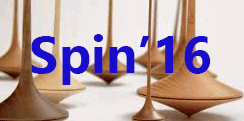Speaker
Description
A fixed-target experiment using the LHC beams (AFTER@LHC) with a polarized target offers a unique opportunity to study the transverse spin structure of a polarized nucleon in a wide kinematical range. Recent studies have shown that a number of single transverse-spin asymmetries (STSA) are large enough to be precisely measured in the kinematical region accessible with AFTER@LHC, in particular for the Drell-Yan process as well as for single-pion, isolated photon, and jet productions. Such measurements would provide a precise handle on the quark Sivers effect. Moreover, AFTER@LHC is the ideal experimental set-up to measure also STSA sensitive to the gluon Sivers effect, of which very little is known, in processes like quarkonium (J/ψ, ψ(2S), Upsilon(1S,2S,3S) even χc) and open charm production.
In this presentation, we will first review the recent ideas about the implementation of the AFTER@LHC with a polarized target: internal - inspired by the LHCb SMOG and HERMES gas-target systems - or used with a beam extracted by a bent crystal - inspired by the LUA9 technology. We will then discuss sensitivity studies for STSA measurements of Drell-Yan, quarkonium, and open charm production.
